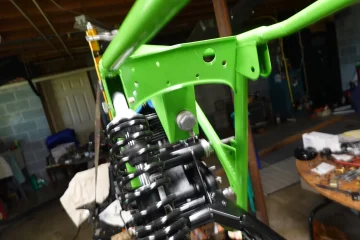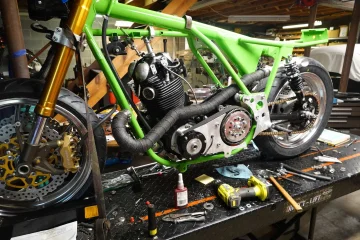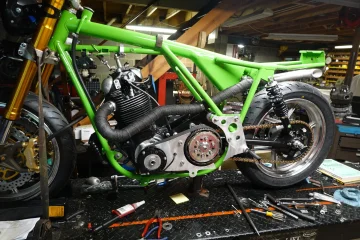Thanks for visiting Access Norton
- Guest view limit reached
- Create a free account (more details)
- Already a member? Click here to login
You are using an out of date browser. It may not display this or other websites correctly.
You should upgrade or use an alternative browser.
You should upgrade or use an alternative browser.
My first hot rod Norton
- Thread starter mean gene
- Start date
mean gene
VIP MEMBER
- Joined
- Dec 21, 2020
- Messages
- 1,302
Installed engine today, there seems to be many ways and threads how to do this, none are wrong this just works best for me. First I install font suspension, so I can hold in lift clamp. and block frame to a approximate height it would naturally be. Note where I placed the block, the rear of the engine needs to rest on it. I installed the front engine ISO mount. Placed a towel over frame and set the engine in. Used temporary bolts ( need to machine Ti studs) to hold in place but did not tighten. This allows the rear of the engine to sag.

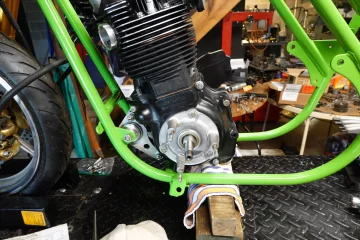
Next is to install cradle. I only use the top ISO bolt and the top cradle to engine bolt. Again this allows it to be below the installed height at the engine. Slide in the transmission and install the top trans bolt.
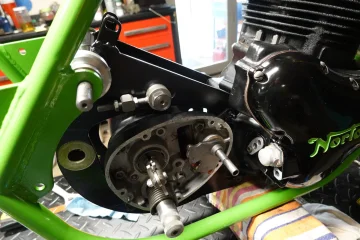
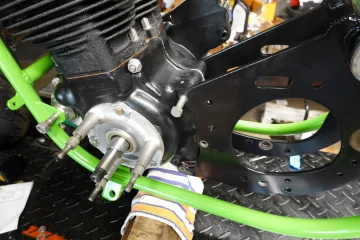
With a soft rag to protect the paint on the frame use a pry bar to raise the engine and cradle until you can install the other two engine bolts. A tapered punch aids in alignment. Easy peasy!
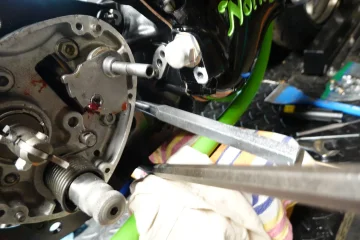
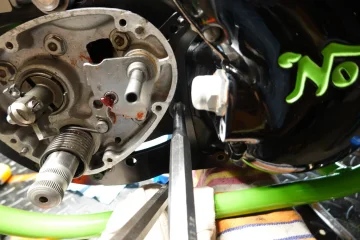
Sorry should have started with this, Tools needed
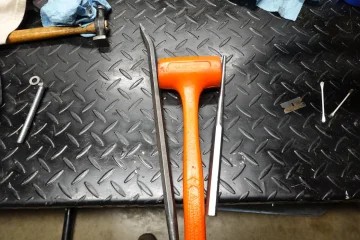
The only difficult bolt to install is the bottom 5/16 engine bolt. A little more pressure on the pry bar will allow the head of the bolt to pass over the frame or you can remove the top bolt and allow it to hinge up easier.
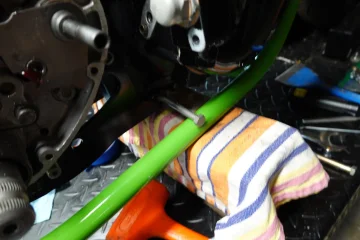


Next is to install cradle. I only use the top ISO bolt and the top cradle to engine bolt. Again this allows it to be below the installed height at the engine. Slide in the transmission and install the top trans bolt.


With a soft rag to protect the paint on the frame use a pry bar to raise the engine and cradle until you can install the other two engine bolts. A tapered punch aids in alignment. Easy peasy!


Sorry should have started with this, Tools needed

The only difficult bolt to install is the bottom 5/16 engine bolt. A little more pressure on the pry bar will allow the head of the bolt to pass over the frame or you can remove the top bolt and allow it to hinge up easier.

mean gene
VIP MEMBER
- Joined
- Dec 21, 2020
- Messages
- 1,302
Got out the new swing arm bushings and pin from AN. Wasn't the greatest fit. Pin was .0005 oversize on left side and .003 on the right side. Good bit of polishing on lathe and sanding on bushing ID to get my proper fit. Forgot to do the MK III modification to cradle be for install, oh well next time. LOL
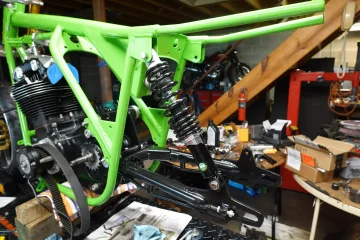

Fast Eddie
VIP MEMBER
- Joined
- Oct 4, 2013
- Messages
- 22,700
You know the frame is green right ???
Richard Tool
VIP MEMBER
- Joined
- Aug 3, 2019
- Messages
- 1,950
Greener than green - rhymes with mean and Gene …You know the frame is green right ???
Gene, that's probably wise. I'd still like to hear how you terminated the oil chamber (i.e., the spine tube) towards the headstock. Did you insert a section in the spine tube containing termination and the filler neck?Sealed frame with KBS tank sealer good to 500 degrees they say.
On another note, I read up on the experience gained by owners of Triumph OIF frames (i.e., T120, T140V, 1971- on). Despite the reduced oil volume, and despite poor heat conduction rate of steel, oil feed temperature *appears* to be lower on hot days.
An exact comparisom to the traditional saddle mounted oil tank is difficult to achieve based on laymen's individual reports.
A few points of concern regarding your arrangement:
* The spine tube is smaller than the one specified for the Triumph OIF, which has an OD of 3".
* Using the smallish spine tube and not a large seat post tube arrangement as on the OIF Triumph means the tube and the oil within will pick up heat from the top end (by radiation and convection). Considering steel's poor heat transfer coefficient, the limited amount of cool air entering the petrol tank tunnel, and the Norton engine's tendency to run "hot", the oil could experience further heat-up.
* If the reservoir you created further down the spine tube is the only reservoir used (i.e., the spine is used as an oil pipe/cooler only), the effective cooling area offered apperars to be less that that of the saddle-mounted oil tank, at least when additional venting is provided for the latter.
* The reservoir appears to limit the possibility of fitting a decent air filter.
* Does the weight budget really favour an OIF solution for the Norton Commando? I have my doubts.
* Having an "oven" immediately below the petrol tank may not be beneficial to safety, in case someone wanted this arrangement for a street bike.
- Knut
Last edited:
The stock Norton oil tank is made from very thin steel. I fully intended to build an alloy oil tank to save weight on my lightweight project bike, but it soon became clear that the thicker alloy tank would weigh the same amount +- as the stock steel Norton tank, about 2 lbs iirc.
Glen
Glen
Glen, you did well. There is also lessons to be learnt from development of the P11.The stock Norton oil tank is made from very thin steel. I fully intended to build an alloy oil tank to save weight on my lightweight project bike, but it soon became clear that the thicker alloy tank would weigh the same amount +- as the stock steel Norton tank, about 2 lbs iirc.
Glen
Improved cooling of the oil tank is obtained by inserting a spoiler (for rear side cooling) and providing louvres in the heat shield.
- Knut
Last edited:
marshg246
VIP MEMBER
- Joined
- Jul 12, 2015
- Messages
- 5,809
If you ever take the engine out, replace that bolt with a stud - much easier to deal with!The only difficult bolt to install is the bottom 5/16 engine bolt. A little more pressure on the pry bar will allow the head of the bolt to pass over the frame or you can remove the top bolt and allow it to hinge up easier.
View attachment 105826
mean gene
VIP MEMBER
- Joined
- Dec 21, 2020
- Messages
- 1,302
TOP frame tube holds 1.9 qt of oil with addition of 1 qt bottom additional tank and the rate of surface area, plus oil cooler, I'll probably have a problem getting it up to running temps! Again I used an epoxy sealer and a top stand pipe for filling! Bottom bolt is now Ti stud.
2.9 qt of oil equals 2.75 litres. That's actually less than the saddle mounted oil tank, which holds 2.85 litres.TOP frame tube holds 1.9 qt of oil with addition of 1 qt bottom additional tank and the rate of surface area, plus oil cooler, I'll probably have a problem getting it up to running temps!
- Knut
Fast Eddie
VIP MEMBER
- Joined
- Oct 4, 2013
- Messages
- 22,700
So he has virtually the same amount of oil, but a far greater surface area (which does help a lot, I know from previous oil in frame mods).2.9 qt of oil equals 2.75 litres. That's actually less than the saddle mounted oil tank, which holds 2.85 litres.
- Knut
So, I’m really failing to see what he’s done ‘wrong’ here Knut.
The guy is getting on with it. Building his version of a ‘hot rod’.
Others are welcome to get on with theirs however they wish.
So he has virtually the same amount of oil, but a far greater surface area (which does help a lot, I know from previous oil in frame mods).
So, I’m really failing to see what he’s done ‘wrong’ here Knut.
As for the alleged "greater surface area", there is a big difference between theoretical figures of an area, and the effective surface area available for cooling, both with respect to shielding, incoming heat flux from the engine, and steel's poor heat conduction property.
A comparison with Triumph's OIF is misleading on several acoounts, one being that that the Triumph engineers wisely put the oil chamber away from the engine.
Upon carefully reading user reports of Triumph OIF bikes, I have concluded that heat conduction between remote frame sections is highly overrated. There are few other road bikes to compare notes with, one being the Vincent in various guises.
The latter has virtually no external frame members and a completely different engine.
FE, there is nothing "wrong" with Gene's build, and everyone may pursue whatever idea they have, preferably after considering the facts. I just aired some concerns, which may be contradicted of course. Maybe Gene's version of an OIF actually works and I will salute him!
- Knut
Last edited:
Fast Eddie
VIP MEMBER
- Joined
- Oct 4, 2013
- Messages
- 22,700
FE, there is nothing "wrong" with Gene's build, and everyone may pursue whatever idea they have, preferably after considering the facts. I just aired some concerns, which may be contradicted of course. Maybe Gene's version of an OIF actually works and I will salute him!
- Knut
Indeed, with ‘decent’ volume and surface area I am sure it will work just fine.
Looking forward to watching the progress….
I believe Kenny Dreer used OIF on his 880 bikes.
On the Vincents, which are OIF as Knut mentioned, we do have the problem of the oil not getting hot enough, as Gene mentioned. It doesn't seem to result in any real operating or longevity issue, but it does take about a half hour of running to get the oil up to normal operating temps.
I believe the problem Kenny Dreer had with his OIF conversion of the Norton frame was oil starvation at times, so that might be worth investigating.
Maybe he had the oil pickup in the wrong location, like the scavenge pickups on Combats?
It could be that simple.
Gene has likely already thought of this and has it covered/corrected.
On edit- I see that Gene has a small oil tank as well so that must be where the oil lines connect?
Oil starvation shouldn't be any problem with that arrangement.
CNW Norton also converted at least one Commando frame to OIF.
Glen
On the Vincents, which are OIF as Knut mentioned, we do have the problem of the oil not getting hot enough, as Gene mentioned. It doesn't seem to result in any real operating or longevity issue, but it does take about a half hour of running to get the oil up to normal operating temps.
I believe the problem Kenny Dreer had with his OIF conversion of the Norton frame was oil starvation at times, so that might be worth investigating.
Maybe he had the oil pickup in the wrong location, like the scavenge pickups on Combats?
It could be that simple.
Gene has likely already thought of this and has it covered/corrected.
On edit- I see that Gene has a small oil tank as well so that must be where the oil lines connect?
Oil starvation shouldn't be any problem with that arrangement.
CNW Norton also converted at least one Commando frame to OIF.
Glen
Last edited:
I believe Kenny Dreer used OIF on his 880 bikes.
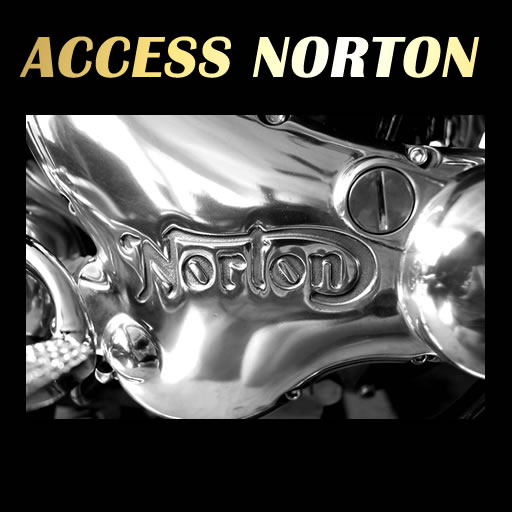
The Kenny Dreer VR880 undressed
I have been planning on doing some kind of blog on this bike for Jerry. As you'll see, it's somewhat apart now so I don't have any clean pix of the whole bike. It may be awhile till I get it back to photo stage, so here is what it looks like under the skins. Just so everyone knows these...
Another thread on the subject OIF:
Oil in frame commando
In about 1971 when I still had my 1966 Matchless Norton, I was sure the frame had been bent slightly, as if a previous owner ha run into a parked car or wall at a fairly low speed. But still enough to put a slight wrinkle where the down tube joins the steering tube and just above that two inch...
- Knut
Last edited:
Richard Tool
VIP MEMBER
- Joined
- Aug 3, 2019
- Messages
- 1,950
I guess you are to busy butt dialing people … lolOn ward with assembly! This exhaust pipe came out of the frame but with the wrap won't go back in without removing bottom shock bolt and jacking the frame up 2 inches. Design flaw!!!!!!
View attachment 106053
Similar threads
- Replies
- 0
- Views
- 330
- Replies
- 79
- Views
- 9,297

